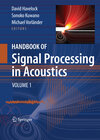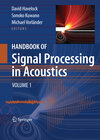
From the reviews:
“The ‘Handbook of Signal Processing in Acoustics’ provides an excellent reference for practicing acousticians and engineers. … encompasses essential background material, technical details, standards, and practical tips. It is aimed to a public with some knowledge of signal processing, and it is meant to be used as a reference. … Signal processing techniques which find major application in different areas of acoustics are well presented from different perspectives … . this compendium is an excellent reference for engineers and professionals working in acoustics.” (Joaquin E. Moran, Noise Control Engineering Journal, Vol. 58 (6), November-December, 2010)Handbook of Signal Processing in Acoustics
herausgegeben von David Havelock, Sonoko Kuwano und Michael VorländerAcoustics has a special relationship with signal processing. Many concepts in signal processing arise naturally from our general experience with sound and vibration and, more than in many other fields, acoustics is concerned with the acquisition, analysis, and synthesis of signals. Consequently, there is a rich resource of signal processing expertise within the acoustics community. There are many excellent reference books devoted to signal processing but the objective of the Handbook of Signal Processing in Acoustics is to bring together the signal processing expertise specific to acoustics and to capture the interdisciplinary nature of signal processing within acoustics. It is also hoped that the handbook will promote networking and the interchange of ideas between technical areas in acoustics. The handbook comprises 104 Chapters organized into 17 Parts. Each Part addresses a technical area of acoustics, reflecting the general demarcations of specialization within the acoustics community. An expert with broad knowledge of signal processing within their respective technical area was invited to act as a Section Leader for each Part of the handbook. These Section Leaders contributed substantially to the handbook project by helping to define the contents and scope of each chapter, finding an appropriate contributing expert author, and managing the review and revision of material. Collectively with the Editors, they form the Editorial Board for the handbook.






